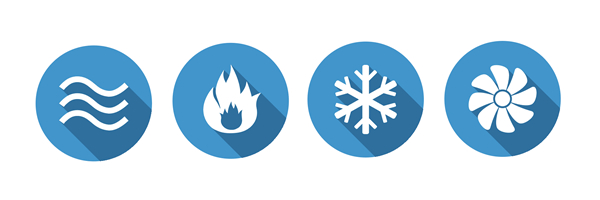
Checking the heating and cooling system is one of the most important parts of routine home maintenance and one that many homeowners pay little attention to. Once they learn, however, that the price of a new system could set them back between $5,000 and $7,000 their interest in maintaining it increases.
You may want to replace the system anyway when you consider that maintaining an old or inefficient unit is almost as costly as replacing it. In addition, the operating cost of a dated system is far more than that of newer, energy-efficient heating and cooling systems.
Heating and cooling your home, according to the experts at the Department of Energy (DOE), eat up almost half of your energy bill.
Before you replace that system, let’s take a quick look at what types of heating and cooling systems are available.
Central Heating and Cooling Systems
These are the most common systems in the United States. They’re inexpensive and popular because the air conditioning system can be combined with the heating system.
The central heating system works by heating air in a furnace and distributing it throughout the home, via ducts and heat registers.
The disadvantages of central heating include
- Leaky ducts: If the ducts aren’t insulated properly or they leak, they waste energy.
- Size of the ducts: because they are large they take up space that could be used for other purposes.
- Dust: Ducts tend to gather dust which is then distributed into the living areas of the home.
Hot Water
Hot water is used in two types of systems, the radiator and radiant floor heating. Both systems work by distributing heat from a boiler to either the radiator or a system of pipes beneath the floor. Some radiant floor systems utilize electric cables instead of hot water.
Mini-Split System
This system is also known as the ductless air-cooling system. While it’s similar to the ducted system it’s smaller size makes it ideal for smaller areas.
Geothermal
If you want to go ultra-modern with your heating and cooling system, consider the geothermal system. The geothermal heat pump gathers heat from the earth and distributes it throughout the home. To cool the home, it does the opposite, taking heat from the home and depositing it in the earth.
Geothermal systems are quite efficient and can result in a 70 percent reduction in the cost of heating a home and a 50 percent reduction in cooling costs. The biggest drawback is that installation of a geothermal system is quite costly.
Even newer systems should be inspected, cleaned and serviced once a year.
2025-11-07
How is Your HVAC System?
2025-11-03
Get Your Home Ready for Spring
2025-10-30
Is your Vegetable Garden ready for Winter
2025-10-26
Update your Bathroom this Weekend
2025-10-22
The Modern Baby Nursery
2025-10-18
Dealing with Wet Basements
2025-10-14
Alternatives to Granite Countertops
2025-10-10
Redecorate the Kitchen on a Shoestring Budget
2025-10-06
The Brag Book
2025-10-02
Seller Remorse
2025-09-28
How to Sell and Buy a House at the Same Time
2025-09-24
Downsizing: It is not just for Retirees
2025-09-20
3 Renovations that Will NOT Increase your Value
2025-09-16
Is a Smart Home in your Future?
2025-09-12
Autumn DIY Project: The Mudroom
2025-09-08
4 Steps to an Organized Garage
2025-09-04
3 Steps to a Healthier, Happier Home
2025-08-31
Your Part in the Home Sale Process
2025-08-27
Three Ways to Prepare for the Appraiser
2025-08-23
3 Ways to Keep a Low Appraisal from Derailing the Deal
2025-08-19
3 Things that can Negatively Impact your Home
2025-08-15
3 Surprising things that Positively Impact Home Value
2025-08-11
The Pet Predicament
2025-08-07
Selling the Home Yourself: Is it a Good Idea?
2025-08-03
Selling in Winter? Make your Home the Hottest on the Market



Recent Comments